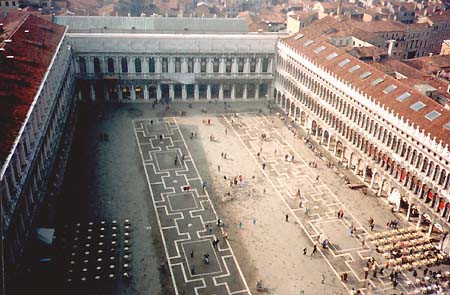One of the world's best-known historical sites, Piazza San Marco is surrounded by some remarkable monuments – the Basilica (originally the Doge's private chapel!), the Torre dell'Orologio, the Procuratie Nuove and the Procuratie Vecchie, Sansovino's Libreria Marciana, and finally the Ala Napoleonica which today houses the Museo Correr.
Towards the end of 1805, Venice became second city in the recently created Kingdom of Italy, with the viceroy Eugène de Beauharnais ruling the capital Milan. Crowned King of Italy earlier that year on 26 May, Napoleon soon realised that in Venice he needed large site for his administration and that he also required lodgings for his (potentially significant) court when on state visit.
As his site he chose Piazza San Marco, the political and religious centre of the old Venetian Republic, selecting the Zecca (mint), the Libreria Marciana and the Procuratie Nuove as the buildings to house the large royal palace. Unfortunately they were not sufficiently large for his needs: a vast room was required for fêtes and public ceremonies, as was a monumental staircase and an entrance onto the piazza itself. And so, to comply with this triple necessity Napoleon ordered the construction of the Ala Napoleonica opposite the Basilica.
At the end of the pre-existing piazza facing the Basilica stood a asymetrical tripartite ensemble comprising the church San Geminiano and the two wings (or ale in Italian) of the Procuratie Vecchie and Nuove. After the intervention of Eugène de Beauharnais, the project was awarded to the architect Giovanni Antonio Antolini whose initial idea was to demolish the ensemble. After many changes and the replacement of Antolini by Giuseppe Maria Soli assisted by Lorenzo Santi, the new building was finally finished in 1836 during the Austrian occupation. Neither Napoleon nor Beauharnais ever visited the site but it was to preserve its name in commemoration of the fact that it was begun during the French occupation.
The Ala Napoleonica completed Piazza San Marco bringing it coherence and unity. The façade facing the Basilica takes as its inspiration the Procuratie Nuove. The façade towards the Ascensione is more unified and based on Sansovino's Libreria.
In the centre of the building there is a large portego (the Sotoportego San Geminiano) which links Piazza San Marco with the rest of the city. It also gives access to the grand staircase, itself a monumental masterpiece of Neoclassicism, which was decorated by Giuseppe Borsato, the last of the great Venetian painter/interior decorators who had similarly worked on the Fenice opera house. Flights with balusters, Ionic pilasters, facings in stone and pink marble, bas-reliefs of winged Victories and garlands, military trophies and scenes from ancient history complete this elegant ensemble. The ceiling fresco The Triumph of Neptune is the work of Sebastiano Santi.
The grand staircase leads to a salon, at present housing the bookshop of the Museo Correr and which at the time served as vestibule to the ballroom. The walls and the ceiling are decorated with frescoes and paintings in cameo executed by Borsato and his workshop. The Ballroom was completed much later on – its fine balustrade, elegant colonnade and wealth of ornament make it an excellent venue for prestige events such as concerts and exhibitions. The Throne room was built for Napoleon I in his role as King of Italy. The Ala Napoleonica is linked by a long corridor which has windows overlooking Piazza San Marco.
For several years now the Musei Civici Veneziani have been engaged in the restoration and conservation of the building complex housing the Museo Correr. Particular importance has been given to the Ala Napoleonica. The work was begun with a spectacular restoration of the ballroom. The Comité Français de Sauvegarde de Venise (the French Save Venice Committee) has taken responsibility for the restoration of the central part of the building. Work is concentrated in three main areas: the Portego San Geminiano, the grand staircase and the vestibule of the ballroom. The Napoleon Foundation is a partner in this enterprise. For more details, see the interview with Jérôme Zieseniss, president of the Comité Français de Sauvegarde de Venise.
Karine Huguenaud


